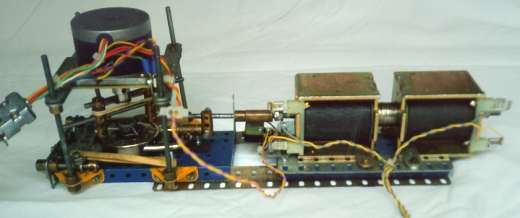Hacking safes with brute force
Students at the Massachusetts Institute of Technology designed the second generation of the Autodialer robot , which breaks safes by sorting out combinations.
The robot is controlled from a laptop via an Atmel microcontroller via a USB port, the motion algorithm of the servomotor and stepper is implemented as a Java program with a GUI interface, plus two thousand lines of microcontroller firmware code.

The first robot introduced last year to handle the Sargent and Greenleaf 8400 . This is one of the best castles in the world that has been used by the feds for over 30 years and has only recently been replaced with a new castle with additional electronic protection. Nevertheless, the Sargent and Greenleaf 8400 is quite reliable and cannot be opened with methods that are suitable for breaking locks of the 2nd category.
The second-generation robot is already successfully coping with the Sargent and Greenleaf 8500 lock .
Both of these locks have 1 million possible combinations. Students used some kind of spatial optimization: thanks to the study of "mechanical tolerances and" dead zones "of some combinations," they managed to reduce the number of acceptable combinations by an order of magnitude. Thus, breaking the lock takes several hours.
Of course, MIT students are not the only ones interested in this topic. From open sources, at least one computer-controlled device for breaking mechanical locks is known : Locraker selects a three-digit combination on average within 30 minutes.

But here we are talking about very simple locks, like on bags, diplomats or bicycles. Even a Lego robot can handle such a simple lock.
The robot is controlled from a laptop via an Atmel microcontroller via a USB port, the motion algorithm of the servomotor and stepper is implemented as a Java program with a GUI interface, plus two thousand lines of microcontroller firmware code.

The first robot introduced last year to handle the Sargent and Greenleaf 8400 . This is one of the best castles in the world that has been used by the feds for over 30 years and has only recently been replaced with a new castle with additional electronic protection. Nevertheless, the Sargent and Greenleaf 8400 is quite reliable and cannot be opened with methods that are suitable for breaking locks of the 2nd category.
The second-generation robot is already successfully coping with the Sargent and Greenleaf 8500 lock .
Both of these locks have 1 million possible combinations. Students used some kind of spatial optimization: thanks to the study of "mechanical tolerances and" dead zones "of some combinations," they managed to reduce the number of acceptable combinations by an order of magnitude. Thus, breaking the lock takes several hours.
Of course, MIT students are not the only ones interested in this topic. From open sources, at least one computer-controlled device for breaking mechanical locks is known : Locraker selects a three-digit combination on average within 30 minutes.

But here we are talking about very simple locks, like on bags, diplomats or bicycles. Even a Lego robot can handle such a simple lock.
